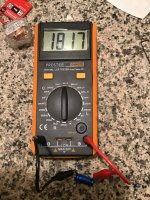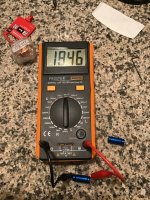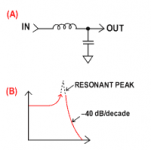so putting capacitors in parallel.
couple questions.
1) does say putting one cap in a xo with a value of 18uf make a sonic difference rather than having one 16uf cap jumped by another cap of 2uf ( =18uf) ? Is better to have just one cap with the 18uf value or the two jumped equaling that value?
2) does the cap you put on to jump the other make the sonic difference? For example if you had a cheap electrolytic and jumped it with a poly cap, would the sonic characteristics be that of the poly cap?
thanks in advance !
couple questions.
1) does say putting one cap in a xo with a value of 18uf make a sonic difference rather than having one 16uf cap jumped by another cap of 2uf ( =18uf) ? Is better to have just one cap with the 18uf value or the two jumped equaling that value?
2) does the cap you put on to jump the other make the sonic difference? For example if you had a cheap electrolytic and jumped it with a poly cap, would the sonic characteristics be that of the poly cap?
thanks in advance !
Last edited:
Capacitors in parallel;
C1 + C2 = total value. So 16 + 2 = 18.
That's it.
The rest of your question regarding 'sonic difference' I cannot answer as it is perceived in the listener.
Tell them it sounds better and it will.
C1 + C2 = total value. So 16 + 2 = 18.
That's it.
The rest of your question regarding 'sonic difference' I cannot answer as it is perceived in the listener.
Tell them it sounds better and it will.
Yeah the power of suggestion is pretty strong.
I’ll see what happens. This is the fun part after all
I’ll see what happens. This is the fun part after all
The only real difference between a single and two paralleled caps is the ESR, that goes lower with the multiple parallel caps (it follows the resistors rules). If it is advisable or not to lower the ESR depends on the application. For example adding a film cap in parallel to an electrolytic one in a crossover is generally not a good idea if the designer used the ESR on the electrolytic cap into the design.
Ralf
Ralf
How high can the ESR be on an electrolytic?
legit question.
i mean my xo uses one 16uf ALCAP in the woofer circuit. ( which is actually 18uf after i measured)
These caps say they are low loss and low ESR.
so I don’t think Proac were going for ESR in the design but rather size and cost.
a poly 18uf cap would have been huge on the board.
also interesting that they say 16uf but both measured at 18uf.
the speakers are only 2.5 years old. Couldn’t have drifted that much in such a short time. They are +-10%. So did the original design call for 16uf?
https://www.falconacoustics.co.uk/a...lectrolytic-capacitors-low-loss-50v-100v.html
legit question.
i mean my xo uses one 16uf ALCAP in the woofer circuit. ( which is actually 18uf after i measured)
These caps say they are low loss and low ESR.
so I don’t think Proac were going for ESR in the design but rather size and cost.
a poly 18uf cap would have been huge on the board.
also interesting that they say 16uf but both measured at 18uf.
the speakers are only 2.5 years old. Couldn’t have drifted that much in such a short time. They are +-10%. So did the original design call for 16uf?
https://www.falconacoustics.co.uk/a...lectrolytic-capacitors-low-loss-50v-100v.html
Attachments
Last edited:
Yeah I’m baffled. No pun intended. Lol
made a separate thread on it, because it’s a head scratcher to me.
made a separate thread on it, because it’s a head scratcher to me.
In my opinion, avoiding parallel capacitors is the preferred way to go.
At least in the audio path, PS supplies are different.
And as for crossovers a few uF differences do not make a hearable difference... I challenge anyone to tell the difference between 18uF and a standard value 22uF in a crossover........ with their EARS, not using lab equipment.
At least in the audio path, PS supplies are different.
And as for crossovers a few uF differences do not make a hearable difference... I challenge anyone to tell the difference between 18uF and a standard value 22uF in a crossover........ with their EARS, not using lab equipment.
I accept that challenge. Lol.
sorry but I do. It made a discernible difference that I could easily tell even blindfolded.
i am a musician though so my ears are quite trained. Not bragging , just stating an important variable.
but why would you avoid parallel caps in the long run? Does it alter the DCR that much?
thanks
sorry but I do. It made a discernible difference that I could easily tell even blindfolded.
i am a musician though so my ears are quite trained. Not bragging , just stating an important variable.
but why would you avoid parallel caps in the long run? Does it alter the DCR that much?
thanks
I accept that challenge. Lol.
sorry but I do. It made a discernible difference that I could easily tell even blindfolded.
i am a musician though so my ears are quite trained. Not bragging , just stating an important variable.
but why would you avoid parallel caps in the long run? Does it alter the DCR that much?
You can use any circuit that works for you, and many do use bypass capacitors with larger film or electrolytics
and like the results. Of course, adding any component to a crossover does change the results, to some extent.
This is a very old technique. Some comments on bypassing are here:
https://www.humblehomemadehifi.com/Cap.html
I don’t think Proac were going for ESR in the design but rather size and cost.
The ESR of the electrolytic tends to help damp the resonant peak in the response of the low pass filter.
Attachments
The ESR of the electrolytic tends to help damp the resonant peak in the response of the low pass filter.
what would that resonant peak sound like?
me putting a poly cap there , I don’t think made a difference with the resonant peak.
it does sound different.
YesYou put a poly cap in the bass filter?
wanted to see the difference
why?
what would that resonant peak sound like?
A resonant peak would emphasise a narrow band of frequencies as shown in diagram (B) of my attachment.
DCR in the circuit, contributed by both the inductor and the electrolytic capacitor, helps damp the resonant peak.
I don’t see a resonant peak in my measurements I took after the change.
wouldn’t it show up there?

wouldn’t it show up there?
Bear in mind that the frequency response of the complete speaker system is not the same
as the frequency response of part or all of the crossover circuit.
as the frequency response of part or all of the crossover circuit.
Bear in mind that the frequency response of the complete speaker system is not the same
as the frequency response of part or all of the crossover circuit.
what’s the difference?
wouldnt that resonant peak show up in the system ?
legit question.
thanks man
what’s the difference?
wouldnt that resonant peak show up in the system ?
legit question.
thanks man
Everything interacts.
The filter response changes when connected to the driver, speaker wires, and the amplifier.
Even if there were no such interaction, if the peak region were higher in frequency than the woofer's drop off,
it would not increase something that is not there in the first place.
And you don't know the operating Q of the LP filter anyway, it could be lower rather than higher.
wouldn’t it show up there?
There will be a more complicated interaction when all the components are taken into account.
- Home
- Loudspeakers
- Multi-Way
- Jumping capacitors (parallel)


